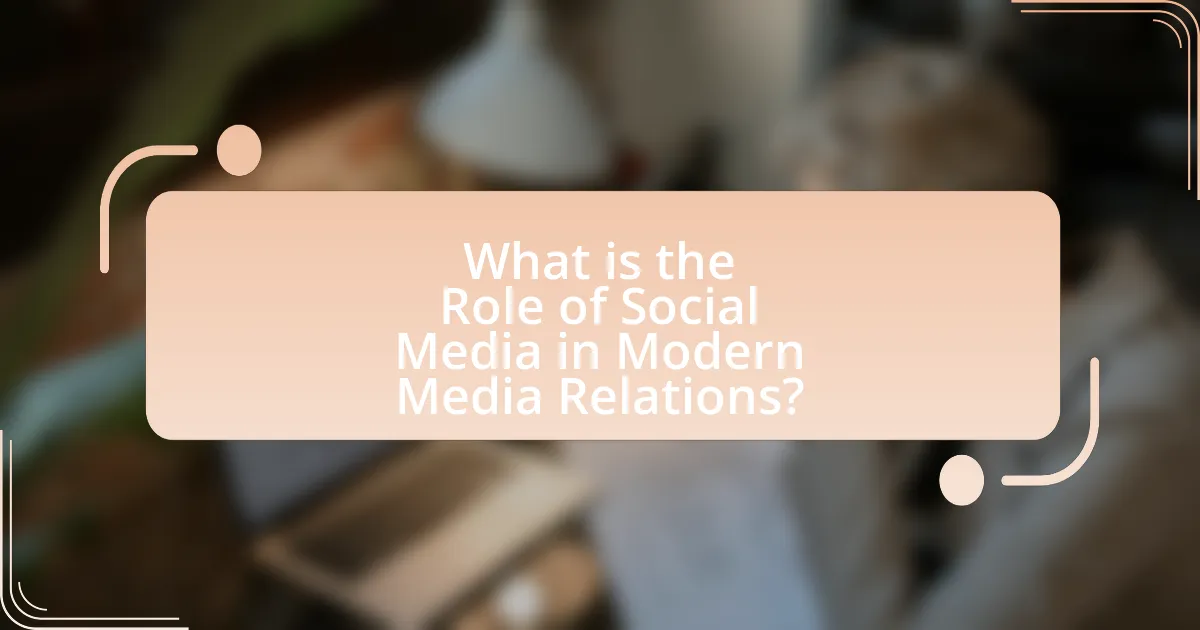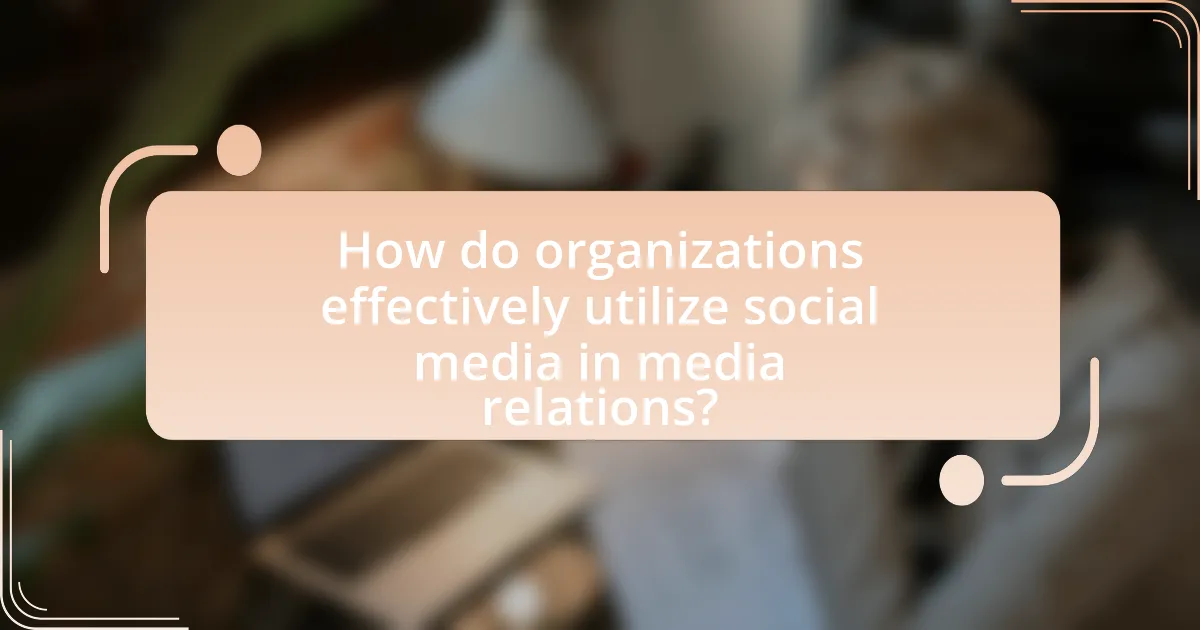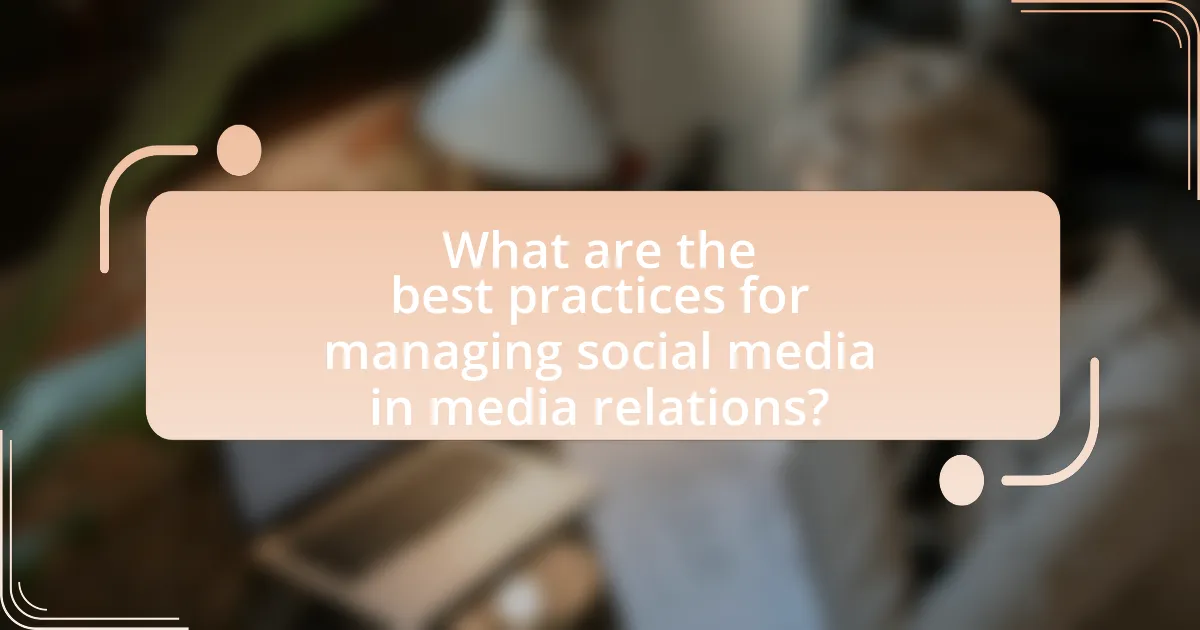The article examines the significant role of social media in modern media relations, highlighting its function as a direct communication channel between organizations and their audiences. It discusses how social media has transformed traditional media relations by enabling real-time engagement, allowing organizations to share news and manage public perception more effectively. Key differences between traditional media and social media interactions are outlined, emphasizing the immediacy and interactivity of social media. The article also addresses the challenges posed by misinformation and rapid news cycles, while providing strategies for effective social media engagement, audience analysis, and performance measurement to enhance media relations.

What is the Role of Social Media in Modern Media Relations?
Social media plays a crucial role in modern media relations by facilitating direct communication between organizations and their audiences. This platform allows for real-time engagement, enabling organizations to share news, respond to inquiries, and manage their public image more effectively. According to a 2021 study by the Pew Research Center, 53% of adults in the U.S. reported getting news from social media, highlighting its significance as a primary information source. Additionally, social media enables organizations to monitor public sentiment and trends, allowing for timely adjustments in communication strategies.
How has social media transformed traditional media relations?
Social media has transformed traditional media relations by enabling direct communication between organizations and their audiences, bypassing traditional gatekeepers like journalists. This shift allows for real-time engagement, where companies can share news, respond to inquiries, and manage crises more effectively. For instance, a study by the Pew Research Center in 2021 found that 53% of Americans get news from social media, highlighting its role as a primary information source. Additionally, social media platforms facilitate the rapid dissemination of information, allowing organizations to reach larger audiences instantly, which contrasts with the slower, more controlled processes of traditional media outlets.
What are the key differences between traditional media relations and social media interactions?
Traditional media relations primarily involve communication through established channels such as newspapers, television, and radio, while social media interactions occur on platforms like Facebook, Twitter, and Instagram. Traditional media relations typically require a longer lead time for content creation and dissemination, often relying on press releases and scheduled interviews, whereas social media allows for real-time engagement and immediate feedback from audiences.
Additionally, traditional media often targets a broader audience through mass communication, while social media enables targeted messaging to specific demographics based on user data. The interactivity of social media fosters two-way communication, allowing organizations to engage directly with their audience, unlike traditional media, which is generally a one-way communication channel.
These differences highlight the evolving landscape of media relations, where social media has become a crucial tool for immediate and interactive communication, contrasting with the more formal and delayed nature of traditional media.
How do social media platforms facilitate communication between organizations and the media?
Social media platforms facilitate communication between organizations and the media by providing real-time channels for information sharing and engagement. These platforms enable organizations to disseminate news, updates, and press releases directly to journalists and the public, bypassing traditional gatekeeping mechanisms. For instance, Twitter allows organizations to share concise updates that can be quickly picked up by media outlets, while platforms like Facebook and LinkedIn enable more in-depth storytelling and audience interaction. According to a 2021 Pew Research Center study, 53% of journalists reported using social media to discover news, highlighting its critical role in modern media relations.
Why is social media important for media relations today?
Social media is important for media relations today because it facilitates real-time communication and engagement between organizations and their audiences. This immediacy allows media professionals to disseminate information quickly, respond to inquiries, and manage public perception effectively. According to a 2021 Pew Research Center study, 53% of U.S. adults reported getting news from social media, highlighting its role as a primary news source. Additionally, social media platforms enable targeted outreach, allowing media relations teams to connect with specific demographics and influencers, thereby amplifying their messages and enhancing visibility.
What advantages does social media provide for public relations professionals?
Social media provides public relations professionals with enhanced communication, real-time engagement, and broader audience reach. These platforms allow PR professionals to disseminate information quickly and efficiently, enabling immediate interaction with stakeholders and the public. For instance, a study by the Public Relations Society of America found that 78% of PR professionals believe social media has improved their ability to communicate with audiences. Additionally, social media analytics tools offer valuable insights into audience behavior and preferences, allowing for more targeted and effective campaigns.
How does social media enhance audience engagement in media relations?
Social media enhances audience engagement in media relations by facilitating real-time interaction and feedback between organizations and their audiences. This immediacy allows media relations professionals to respond quickly to inquiries, share updates, and engage in conversations, thereby fostering a sense of community and connection. According to a 2021 study by the Pew Research Center, 69% of adults in the U.S. use social media, which indicates a significant platform for organizations to reach and engage their target audiences effectively. Furthermore, social media analytics provide insights into audience preferences and behaviors, enabling tailored communication strategies that resonate more deeply with specific demographics.
What challenges does social media present in media relations?
Social media presents several challenges in media relations, primarily including misinformation, rapid news cycles, and the difficulty of controlling narratives. Misinformation can spread quickly on platforms like Twitter and Facebook, leading to public confusion and damaging reputations before accurate information can be disseminated. Rapid news cycles mean that media relations professionals must respond almost instantaneously to emerging stories, which can lead to mistakes or incomplete messaging. Additionally, the decentralized nature of social media makes it challenging for organizations to control their narratives, as multiple voices can contribute to the conversation, often leading to conflicting messages. These challenges necessitate a strategic approach to media relations that incorporates social media monitoring and proactive engagement.
How can misinformation on social media impact media relations?
Misinformation on social media can significantly undermine media relations by eroding trust between media organizations and their audiences. When false information spreads rapidly, it creates confusion and skepticism, leading audiences to question the credibility of legitimate news sources. A study by the Pew Research Center found that 64% of Americans believe that misinformation has caused confusion about basic facts, which directly impacts how media outlets are perceived. Consequently, media organizations may face increased scrutiny and challenges in maintaining their reputation, as they must work harder to verify information and combat false narratives. This dynamic can strain relationships with both the public and other media entities, ultimately affecting the overall effectiveness of communication strategies in the digital age.
What are the risks of relying solely on social media for media communications?
Relying solely on social media for media communications poses significant risks, including misinformation, lack of control over messaging, and audience fragmentation. Misinformation can spread rapidly on social media platforms, leading to the dissemination of false information that can damage reputations and mislead audiences. A study by the Pew Research Center found that 64% of Americans believe that fabricated news stories cause confusion about the basic facts of current events. Additionally, organizations lose control over their messaging when they depend exclusively on social media, as user-generated content can distort intended messages. Furthermore, audience fragmentation occurs because different demographics use various platforms, making it challenging to reach a unified audience effectively. According to a report by Statista, as of 2023, over 4.9 billion people use social media, but their preferences vary widely, complicating targeted communication strategies.

How do organizations effectively utilize social media in media relations?
Organizations effectively utilize social media in media relations by engaging directly with their audience, disseminating timely information, and building relationships with journalists. This approach allows organizations to respond quickly to news events, share press releases, and provide updates in real-time, which enhances transparency and fosters trust. For instance, a study by the Pew Research Center found that 53% of journalists use social media to find story ideas, indicating that organizations can leverage these platforms to reach media professionals directly. Additionally, social media enables organizations to monitor public sentiment and media coverage, allowing them to adjust their communication strategies accordingly.
What strategies can organizations implement for effective social media engagement?
Organizations can implement several strategies for effective social media engagement, including creating high-quality, relevant content tailored to their audience, actively responding to comments and messages, and utilizing analytics to refine their approach. High-quality content, such as informative articles or engaging videos, attracts and retains audience attention, while timely responses to user interactions foster a sense of community and trust. Additionally, leveraging analytics tools allows organizations to track engagement metrics, enabling them to adjust their strategies based on what resonates most with their audience. According to a 2021 report by Hootsuite, brands that engage with their audience on social media see a 20-40% increase in customer loyalty, highlighting the importance of these strategies in building lasting relationships.
How can organizations create compelling content for social media platforms?
Organizations can create compelling content for social media platforms by focusing on audience engagement, storytelling, and visual appeal. Engaging content resonates with the target audience, prompting interactions such as likes, shares, and comments. Storytelling allows organizations to convey their brand message in a relatable manner, fostering emotional connections. Additionally, incorporating high-quality visuals, such as images and videos, enhances the attractiveness of the content, as studies show that posts with visuals receive 94% more views than those without. By combining these elements, organizations can effectively capture attention and drive engagement on social media.
What role does audience analysis play in social media strategy?
Audience analysis is crucial in social media strategy as it enables organizations to tailor their content and messaging to meet the specific needs and preferences of their target audience. By understanding demographics, interests, and behaviors, brands can create more engaging and relevant content, which increases user interaction and loyalty. Research indicates that 70% of consumers prefer personalized content, highlighting the importance of audience analysis in driving effective social media campaigns.
How can organizations measure the success of their social media efforts in media relations?
Organizations can measure the success of their social media efforts in media relations through key performance indicators (KPIs) such as engagement rates, reach, and sentiment analysis. Engagement rates, which include likes, shares, and comments, indicate how well the audience interacts with the content, while reach measures the number of unique users who see the posts. Sentiment analysis evaluates the tone of the conversations surrounding the brand, providing insights into public perception. According to a 2021 report by Hootsuite, brands that actively engage on social media see a 20% increase in positive sentiment compared to those that do not. This data supports the effectiveness of social media in enhancing media relations by fostering direct communication and feedback from the audience.
What metrics should be tracked to evaluate social media performance?
To evaluate social media performance, key metrics include engagement rate, reach, impressions, follower growth, and conversion rate. Engagement rate measures interactions (likes, shares, comments) relative to total followers, indicating content resonance. Reach quantifies the number of unique users who see posts, while impressions count total views, reflecting visibility. Follower growth tracks audience expansion over time, essential for assessing brand interest. Conversion rate evaluates the effectiveness of social media in driving desired actions, such as website visits or purchases, providing insight into ROI. These metrics collectively offer a comprehensive view of social media effectiveness in achieving communication goals.
How can feedback from social media inform future media relations strategies?
Feedback from social media can inform future media relations strategies by providing real-time insights into audience perceptions and preferences. Social media platforms allow organizations to gauge public sentiment through comments, shares, and likes, enabling them to identify which messages resonate most effectively. For instance, a study by the Pew Research Center found that 69% of adults in the U.S. use social media, making it a vital tool for understanding audience engagement. By analyzing this feedback, organizations can adjust their communication tactics, refine messaging, and enhance their overall media relations approach to better align with audience expectations and improve engagement outcomes.

What are the best practices for managing social media in media relations?
The best practices for managing social media in media relations include establishing a clear strategy, engaging with audiences authentically, monitoring conversations, and measuring performance. A clear strategy ensures that messaging aligns with organizational goals and target audiences, while authentic engagement fosters trust and builds relationships. Monitoring conversations allows media relations professionals to respond promptly to inquiries and manage reputational risks. Measuring performance through analytics helps assess the effectiveness of social media efforts, guiding future strategies. According to a 2021 study by the Pew Research Center, 53% of adults in the U.S. reported getting news from social media, highlighting the importance of effective management in reaching audiences.
How can organizations maintain a consistent brand voice across social media channels?
Organizations can maintain a consistent brand voice across social media channels by developing a comprehensive brand voice guideline that outlines tone, language, and messaging. This guideline serves as a reference for all content creators within the organization, ensuring that every post aligns with the established brand identity. Research indicates that brands with a consistent voice can increase customer loyalty by up to 23%, highlighting the importance of uniformity in communication. Additionally, regular training sessions for social media teams can reinforce these guidelines, allowing for adaptability while still adhering to the core brand voice.
What guidelines should be established for social media communication?
Guidelines for social media communication should include clarity, professionalism, and responsiveness. Clarity ensures that messages are easily understood, which is crucial for effective communication. Professionalism maintains the organization’s reputation and fosters trust among audiences. Responsiveness involves timely engagement with followers, addressing inquiries and feedback promptly to enhance relationships. Research indicates that organizations that actively engage on social media see a 20% increase in customer satisfaction, highlighting the importance of these guidelines in modern media relations.
How can crisis communication be effectively managed through social media?
Crisis communication can be effectively managed through social media by ensuring timely and transparent information dissemination. Organizations should establish a dedicated crisis communication team that monitors social media channels for real-time feedback and public sentiment. According to a study by the Pew Research Center, 69% of adults in the U.S. use social media, making it a crucial platform for reaching a wide audience quickly during a crisis. Additionally, utilizing clear messaging and engaging directly with stakeholders can help mitigate misinformation and build trust. Research from the Journal of Communication Management indicates that organizations that actively engage with their audience during crises can improve their reputation and stakeholder relationships.
What tools and resources are available for enhancing social media media relations?
To enhance social media media relations, tools such as Hootsuite, Buffer, and Sprout Social are available for managing and scheduling posts, analyzing engagement metrics, and monitoring brand mentions. Hootsuite allows users to manage multiple social media accounts from one dashboard, while Buffer provides analytics to optimize posting times and content. Sprout Social offers comprehensive reporting features that help track audience engagement and sentiment. According to a 2021 report by HubSpot, 73% of marketers believe that social media is effective for their business, highlighting the importance of these tools in fostering effective media relations.
Which social media management tools are most effective for media relations?
Hootsuite, Sprout Social, and Buffer are the most effective social media management tools for media relations. Hootsuite allows users to monitor multiple social media channels, schedule posts, and analyze engagement metrics, making it ideal for managing media outreach. Sprout Social offers robust analytics and reporting features, enabling PR professionals to track the effectiveness of their campaigns and engage with journalists effectively. Buffer simplifies the scheduling process and provides insights into post performance, which helps in optimizing content for media relations. These tools are widely recognized in the industry for enhancing communication and engagement with media stakeholders.
How can analytics tools improve social media strategy in media relations?
Analytics tools can enhance social media strategy in media relations by providing data-driven insights that inform content creation and audience engagement. These tools analyze metrics such as engagement rates, audience demographics, and sentiment analysis, allowing media relations professionals to tailor their messaging effectively. For instance, a study by HubSpot found that companies using analytics to guide their social media strategies experienced a 30% increase in engagement. By leveraging these insights, organizations can optimize their outreach efforts, ensuring that their communications resonate with target audiences and improve overall media relations outcomes.
What practical tips can organizations follow to optimize their social media presence in media relations?
Organizations can optimize their social media presence in media relations by developing a clear content strategy that aligns with their communication goals. This strategy should include identifying target audiences, selecting appropriate platforms, and creating engaging content tailored to each platform’s unique characteristics. For instance, using Twitter for real-time updates and LinkedIn for professional networking can enhance visibility and engagement.
Additionally, organizations should actively monitor social media channels for mentions and feedback, allowing them to respond promptly to inquiries or concerns, which fosters positive relationships with journalists and the public. According to a 2021 study by the Pew Research Center, 53% of journalists reported using social media to find story ideas, highlighting the importance of maintaining an active and responsive presence.
Furthermore, organizations should leverage analytics tools to track engagement metrics, enabling them to refine their strategies based on what resonates with their audience. By consistently sharing relevant news, updates, and insights, organizations can position themselves as credible sources of information, thereby strengthening their media relations.